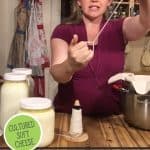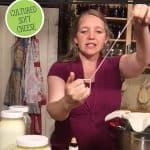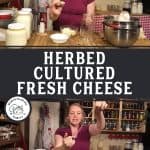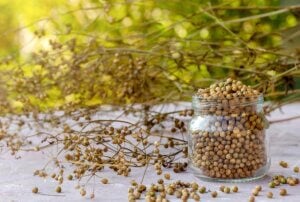








Use this guide to learn how to add to the variety of cultured products in your home by making your own nutritious yogurt cheese marinated in olive oil.

Are you looking into dairy animals for your homestead and need recipes that use up a lot of milk? Whether you’ve purchased a dairy cow or want to make cheese from store-bought milk, you are in the right place.
Table of Contents
ToggleWhy I Love Yogurt Cheese Marinated in Olive Oil
Yogurt cheese marinated in olive oil (aka Labneh) is a delicious way not only to make homemade dairy products practical but also to boost your immune system with good bacteria from fermented foods.
In our home, we often refer to it as “Dream Cheese” because its dreamy consistency makes for a delicious appetizer served with crackers and vegetables or an easy lunch served with a couple of slices of fresh artisan bread.
The fermentation process can preserve the cheese for up to a year, but it’s so delicious that we always consume it long before then. Whether you call it yogurt cheese marinated in olive oil, cheese balls, labneh, or dream cheese, it’s bound to become a staple recipe in your pantry, too.
What Is Labneh
Labneh is a soft cheese made from cow’s milk that originates from Middle Eastern cuisine. You can substitute sheep or goat milk, but I recommend making chevre cheese (or goat cheese) if you have goat’s milk on hand.
You might be wondering if Labneh and cream cheese are the same thing, but they are not. Though many of these products can be used interchangeably, here’s a quick comparison to better understand Labneh versus other dairy products:
| Product | Base Ingredient | Texture | Common Uses |
| Labneh | Strained Yogurt | Creamy, Spreadable | Meze Platters, Spreads, Dessert Toppings |
| Greek Yogurt | Strained Yogurt | Thick, Creamy | Breakfast Bowls, Smoothies, Snacks |
| Cream Cheese | Cow’s Milk | Soft, Spreadable | Bagels, Frosting, Dips |
This recipe for yogurt cheese marinated in olive oil uses Labneh, but you can substitute a soft cheese you have made from kefir or clabbered milk. The entire process takes a few days, but the active work on each of those days is just a few minutes.

How to Serve Yogurt Cheese Marinated in Olive Oil
You can use yogurt cheese marinated in olive oil the same way you would use any other soft cheese such as ricotta, cream cheese, etc. It’s delicious on homemade crackers, crusty bread, spread onto bagels, or even sliced on top of a green salad.
Here are some popular ways to enjoy this versatile cheese.
| Serving Style | Ingredients | Details |
| Spread on Bread | Crusty Bread, Fresh Herbs | Spread the cheese on slices of fresh baguette and garnish with thyme or oregano. |
| With Fresh Vegetables | Bell Peppers, Cucumbers, Cherry Tomatoes | Arrange veggies around a bowl of marinated yogurt cheese for a healthy option. |
| Cheese Board | Sun-Dried Tomatoes, Olives, Crackers | Include the cheese with a variety of Mediterranean accompaniments. |
| Garnished | Toasted Pine Nuts, Honey | Top the cheese with pine nuts or a drizzle of honey for added elegance. |

How to Make Yogurt Cheese Marinated in Olive Oil
Supplies Needed
- Unbleached Muslin – I used a true cheesecloth. When I say “true cheesecloth,” I’m not talking about the cloth that looks a lot like gauze. You should not use that product for cheesemaking. You will need a cloth that is made from unbleached muslin. A food-grade muslin bag that is for making Greek yogurt, leftover muslin from a sewing project, or butter muslin all work well, as does cheesecloth with a thread count of 50 or more. If you don’t have any of these, you can use an old plain white T-shirt. You will just need to properly prepare it by washing it thoroughly and then boiling it to make sure the residual detergent is rinsed out.
- Large Bowl & Colander – Make sure your bowl is large enough for the colander to fit inside.
- Kitchen String – This is just twine or cotton string.
- Small Bowl – You can use the larger bowl to catch the whey, but a second smaller bowl will save counter space.
- Mason Jar – The size of your jar depends on the amount of cheese you intend to make. I use a half-gallon jar because I make several batches over the course of a few days, and keep adding to my jar. If you plan to make just one batch, a quart jar should be sufficient.
- Clean Hands – It is important to use freshly clean hands whenever working with a cultured product. This will prevent foreign bacteria from interfering with the cultures already present in your food product.



Ingredients Needed
- Yogurt, Kefir or Clabbered Milk – We make our own yogurt, but if you don’t have homemade yogurt, you can buy a quality yogurt from the store. Look for plain yogurt (not flavored or sweetened) without thickeners like pectin, milk powders, or gelatin. The ingredients should simply be milk and live active cultures. We make kefir by the half-gallon every day during the dairy season. We use it for smoothies or to culture cheese instead of buying a store-bought culture. If you don’t know what clabbered milk is, go ahead and check out our video on clabbered milk.
- Salt – You will need 1 teaspoon of salt for every quart of yogurt, clabbered milk, or kefir you begin with. Salt not only enhances flavor but also acts as a preservative, inhibiting the growth of bad bacteria so that the cultures already present can continue to develop. Homesteading Hack: We love Redmond Real Salt. Using that link for Redmond Salt will automatically give you 15% off your order!
- Herbs and Spices – The moisture from fresh herbs will cause spoilage, so make sure to use fully dried herbs in this recipe. Feel free to play around with this recipe and use any savory seasonings of your choice.
- Extra Virgin Olive Oil – Use the best quality organic extra virgin olive oil your budget can afford.









Step-by-Step Directions
- Line the colander with cloth, and pour in the yogurt, clabbered milk, or kefir. I had all three on hand but chose to use the kefir and save the yogurt for breakfast and the clabbered milk for making homemade raw milk cottage cheese, plus as a treat for our backyard egg-laying chickens.
- Cut about three feet of string, bring the ends together, tie in a knot, and then loop the string through itself to make a slip knot (demonstration at 5:00 in the video).
- Gather muslin on all sides to make a pouch for the yogurt, clabbered milk or kefir at the bottom. Slip the string over the ends of the muslin and pull tight.
- Lift the pouch out of the colander and hang it to allow the whey to drain out through the muslin. I use the cup hooks in my pantry to hang the pouch, and a small bowl sits below it to catch the whey as it drains.
- Allow the pouch to hang for 12-24 hours.
- Remove the whey from the hook, drain any whey that has collected in the bowl, and open the pouch. At this point, you have what is called “labneh.” You can eat this soft cheese as it is, seasoned with salt and herbs and served on crackers or topped with jam, fruit preserves, or even seasonal fruit. We are going to move onto the next stage, though, to make our cheese into yogurt cheese marinated in olive oil.
- Add salt, and mix thoroughly with a spoon, removing all cheese that has adhered to the muslin as you go.
- Gather the ends of the muslin, make a pouch again, and secure it with the string. Resist the temptation to not use your cheesecloth at this point. It may seem messy, but the original cheesecloth has now been inoculated with good bacteria. By switching to clean cheesecloth, you will reduce the strength of the good bacteria, making it easier for the bad bacteria to cause spoilage.
- Hang for another 24 hours to allow the salt to pull out as much residual moisture as possible. This is an important safety step before marinating in olive oil because moisture under the oil will spoil.
- Remove from the hook, drain any whey that collects in the bowl, open the pouch, and remove the cheese from the cloth into the bowl.
- With clean hands, form cheese into 2” balls, roll in the seasoning of choice and place in a clean jar.
- Pour in enough olive oil to completely submerge the cheese, and cover with a lid.
- For best results, allow the cheese to marinate for a week before consuming. The cheese is safe to eat right away, but waiting will allow the flavor to fully develop.

Storing Yogurt Cheese Marinated in Olive Oil
If you have cold storage that stays consistently cool (50-65°F), you can store the jar of cheese on the shelf as long as the olive oil stays above it.
You can also store the cheese in the refrigerator. However, the olive oil will solidify, and you’ll want to allow the container to come back to room temperature before trying to scoop out the cheese.
If you try scooping them out when everything is solid, you’ll end up with some cheese and some oil and make a big mess. Trust me when I say let this come up to room temperature for about an hour before getting the cheese out.
Did you make this recipe? If you did, please leave a star⭐rating and your comments on the recipe card below. We’d also love to see your finished yogurt cheese, so tag us on social media @homesteadingfamily.
FAQs
Yes, as long as the temperature is consistent and not getting too high, you can safely store your cheese at room temperature for up to 12 months.
If you don’t have anywhere in your home where the temperature is consistently cool, then you can store this cheese in the refrigerator. Just know the olive oil will solidify, and you’ll want to bring it up to room temperature before scooping out the cheese.
If stored properly, your cheese will be safe to eat for up to a year. It will continue to deepen in flavor and taste even better the longer it is stored.
Because this is a cultured soft cheese, beneficial bacteria are already present in the cheese. The good bacteria will essentially destroy any bad bacteria. The salt in the recipe also helps remove excess moisture, further helping to preserve your cheese. So, though there are bacteria, it is beneficial bacteria and good for your body, not harmful.
Yes! You can absolutely use that olive oil, in fact, we encourage it as it’s perfectly good (and frugal) to use it up! We tend to use ours for salad dressings as, occasionally, there will be bits of herbs still in the oil.
Labneh is a soft cheese made from strained yogurt. It’s a key part of Middle Eastern cuisine. It has a creamy texture and a tangy taste that’s both refreshing and rich.
You can serve yogurt cheese marinated in olive oil in many ways. Spread it on crusty bread or serve with fresh veggies. It’s also great on a cheese board. Add fresh thyme, sun-dried tomatoes, or olives for a Mediterranean touch.
Labneh and Greek yogurt are both strained yogurts. But Labneh is thicker and cheesier, with a stronger flavor. Greek yogurt is creamier and milder, making them different in taste and use.
Yes, you can mix yogurt and olive oil. This mix is common in Mediterranean cooking. It adds health benefits and flavor. It’s great for dressings, dips, or marinated cheeses, blending yogurt’s creaminess with olive oil’s richness.
Labneh is often seen as healthier than cream cheese. It has less fat and calories and more probiotics. It’s a nutritious choice compared to traditional cream cheese.
The final product of yogurt cheese marinated in olive oil is amazing. The tartness of the yogurt cheese and the richness of the olive oil create a delicious blend. It’s perfect for anyone who loves gourmet flavors.
Other Posts You May Enjoy
- Easy Instant Pot Yogurt Recipe (Step-by-Step)
- Can You Make Cheese From Store-Bought Milk?
- Recipes That Use a Lot of Milk
- What to Do With Raw Milk
- Making Homemade Dairy Products Practical
- What is Fermentation? A Beginner’s Guide to Getting Started
- How to Boost Your Immune System Naturally – 7 Steps
- Chevre Cheese Recipe (Goat Cheese)

Herbed Yogurt Cheese Marinated in Olive Oil
Equipment
- Unbleached Muslin (or cheesecloth with threadcount of 50 or more)
- Large Bowl & Colander
- Kitchen String
- Mason Jar
Ingredients
- 8 cups milk kefir or yogurt or clabbered milk
- 2 tsp sea salt
- 1/4 cup Italian seasoning
- 4 cups olive oil
Instructions
- Line colander with cloth, and pour in the yogurt, clabbered milk, or kefir.
- Cut about three feet of string, bring the ends together, tie in a knot, and then loop the string through itself to make a slip knot (demonstration at 5:00 in the video). Gather muslin on all sides to make a pouch for the kefir to sit at the bottom, slip the string over the ends of the muslin, and pull tight.
- Lift the pouch out of the colander, and hang to allow the whey to drain out through the muslin. I use the cup hooks in my pantry to hang the pouch with a small bowl sitting below it to catch the whey as it drains. Allow the pouch to hang for 12-24 hours.
- Remove from the hook, drain any whey that has collected in the bowl, open the pouch, and at this point, you have what is called “yogurt cheese” or “kefir cheese”.
- Add salt, and mix thoroughly with a spoon removing all cheese that has adhered to the muslin as you go.
- Gather ends of the muslin, make a pouch again, and secure with the string. Resist the temptation to use a clean cheesecloth at this point. It may seem messy, but the original cheesecloth has now been inoculated with good bacteria. By switching to a clean cheesecloth, you will be reducing the strength of the good bacteria making it easier for the bad bacteria to cause spoilage. Hang for another 24 hours to allow the salt to pull out as much residual moisture as possible.
- Remove from the hook, drain any whey that has collected in the bowl, open the pouch, and remove the cheese from the cloth into the bowl.
- With clean hands, form cheese into 2” balls, roll in seasoning of choice and place in a clean jar. Continue until all cheese has been formed into balls.
- Pour in enough olive oil to completely submerge the cheese, and cover with a lid.
- If you have a consistently cool dark place like a cool pantry, root cellar, wine cellar, or cold storage, this would be the ideal place to store your cheese for up to a year.
Notes
- Don’t be tempted to use a clean cheesecloth or butter muslin on the second day, the cloth has been inoculated with beneficial bacteria and will help keep your cheese strong and full of good bacteria. Switching to a clean cloth will reduce the volume of beneficial bacteria, potentially resulting in cheese that goes bad.
- If you don’t have a cold storage option, the cheese will keep just fine in the refrigerator. You will just need to allow the oil to come back to a liquid state before removing the cheese from the jar to ensure that the remaining cheese is still completely covered with oil before placing the jar back in storage.
- For best results, allow the cheese to marinate for a week before consuming. The cheese is safe to eat right away, but waiting will allow the flavor to fully develop.


















